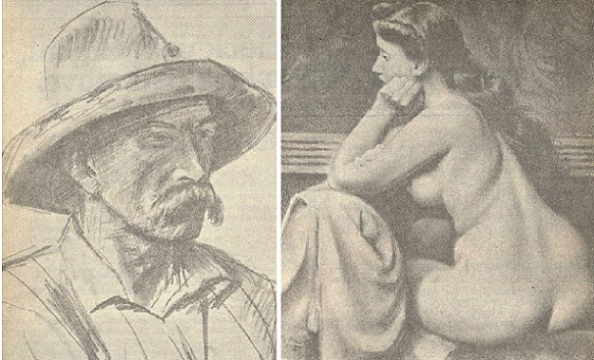by Fred Harris
‘An Artist’s Credo’
We all have special paintings which are personal for various reasons. Sometimes reproductions of a famous picture adorned our parents’ home or was always seen in our school. The subject matter of many of these paintings recall memories of trips or experiences to pleasure. For artists, the reasons are many due to the fact that they paint themselves. It would take an encyclopedic reference work to document all of them correctly.
One reason however which is common to most painters who love the sensuous act of painting is, “I wish I could paint like that.”
A particular personal treasure for me over many years has been a large (almost life-size) portrait of a virile looking man with a huge mustache called “Big Red” painted by Eugene Speicher which is displayed in the Los Angeles County Museum.
Eugene Speicher is one of many great painters who were at one time considered the best there was. Fashions change and new styles and approaches to picture making overshadow many of these painters. Over a period of time most are remembered and known only to a select few — usually artists.
In writing this article I tried to find out the dates of Speicher’s birth and death. Unfortunately, all of the books I have on American art were printed while he was alive. Being out of favor when the new books on world art were published causes his name not to be mentioned at all. Two large dictionaries on art and artists I often refer to make absolutely no reference to “Eugene Speicher.”
Speicher was born in Buffalo, New York, in 1883. In 1907 he entered the Art Students League in New York City and enrolled in the class taught by Frank Vincent Dumond. He must have been one of Dumond’s first students, because I studied with Dumond in 1948, almost a half century later. In 1908, Speicher attended classes at the private school run by Robert Henri. Henri was the “bad boy” in American art history. It was Henri who revolted against the National Academy and led a group of realists called “The Fight” — otherwise known as “The Ashcan School”—in a move to free American Art from the restrictions of academic thinking.
In the 1930s when the world at large was finally becoming aware of the impact of Cezanne on contemporary art even Speicher’s direct unpolished method of applying paint was credited with a Cezanne influence. Today this theory would be laughed at. Eugene Speicher was a pure painter who loved the act of looking at nature and laying down paint in a full, juicy direct method to interpret what he saw.
I’ve read a lot of statements from different artists, but Speicher’s words about his art are something I wish I had said. It gives me pleasure to quote his “Credo” which is as important a part of my world of art, as it was for him.
“My look and feel of the thing I am painting: my imagining and thinking about it, is what I try to express, be it a portrait, a figure, a landscape or a bouquet of flowers. Something that is not merely original and short-lived but which is also supported by fundamental principles of art.
“It must be at once vital and subtle, well made and fresh in spirit. Something that will be a tonic to stir the imagination, a pleasure to the eye and reflect my sense of quality in life. Above all it must have rare flavor and strong grace, be warm, simple and well ordered.
“I have studied and tried to understand the intention of many masters and have never hesitated to allow myself to be influenced when I thought would eventually help me toexpress myself and contribute what personal quality I may have. It seems to have been likewise with the old and modern masters for whom I have reverence.
“An artist is a distinguished shape maker: varied shapes in three dimensions, his main interest in color is in the coloration of the canvas as a whole. I believe that all art is built on a superstructure of abstract design, upon which and out of which the original idea flowers. In believing this, I am interested in acquiring adequate technical skill and concentration to express myself as clearly as possible. I do not like stuttering or double talk in paint any more than I do in real life. I know of no master who is not a master craftsman.
“Any subject that releases me and sets my creative faculties in motion, I believe to be an adequate subject. It is what I take to the subject that is of importance. When I successfully express myself, my work is autobiographic, and registers what appreciation and understanding of life I have.
“I realize fully that the major and most enduring interest in a work of art is an aesthetic one, but I feel this interest can be augmented by an underlying human sympathy.
“While being greatly interested in contemporary life, my work must be more than a chronicle of the time in which I live.
“Good painting has ever-refreshing quality. It is like playing with electricity. Touch one part of the canvas and something immediately happens to some other part. Part must be played against part until the whole acquires a state of living balance and unity. Unity in a work of art is one of its most distinguishing qualities, as is style.
“In a well-organized canvas, parts lose their identity, facts disappear and miracles happen. Eugene Speicher…”









